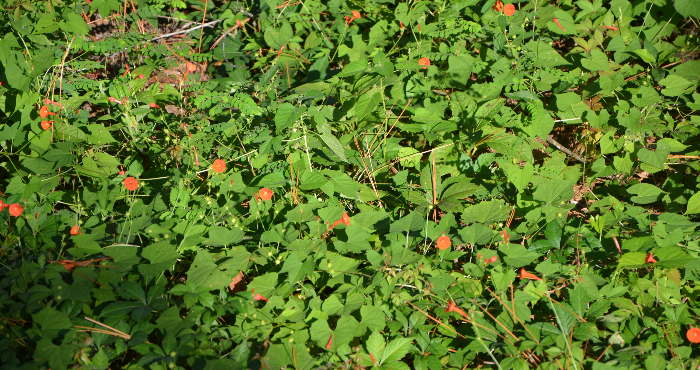August 1, 2019
Exotic invasive plants in Florida are a hot topic, especially as they flourish during the heat of summer. Most arrived here, usually in the last century as part of the international ornamental horticulture trade, from colorful locales worldwide.
These imported plants, now weeds, grow aggressively and colonize new sites with little restraint or reserve. All the while pushing native species to the brink of oblivion.
Vines make great shade cover
Vines are particularly effective at territorial conquest. They will climb over almost anything, then cover the canopy with leaves which shades out the original foliage.

Kudzu – “weed which ate the south”
The most notable example is kudzu, sometimes known as the weed which ate the south. Introduced from East Asia as an erosion solution, this vining plant has invaded thousands of acres costing millions of dollars to control.
Old World Climbing Fern is competing with Kudzu for the most land subjugated by an invasive species. In addition to pushing out native species, it acts as a wildfire accelerant during drought years.
There are, however, some lesser-known native vines which rival the tenacious behavior of the most infamous invasive examples currently plaguing residents of Wakulla County. The best which can be hoped for with these weeds is control, but eradication is highly unlikely.
The Scarlet Morning Glory vine
The Scarlet Morning Glory vine is a member of the morning glory genus, Ipomoea. As it is known scientifically, I. hederifolia is a native of the southeastern U.S., the Caribbean and parts of South America.
The bright red prolific blooms are the reason this annual vine’s seed are occasionally sold as an attractive ornamental for landscapes and container gardening specimen plant. . Additionally, this plant is attractive to hummingbirds which compete for the bloom’s nectar.
Abundant and viable seed supply
Unfortunately, the copious mid-summer blooms are the basis for an abundant and viable seed supply from each plant. This vine quickly escaped into the wild where it tolerates a variety of soil conditions just so long as it is in full sun.
The most productive sites include some moisture with organic matter in the soil, but this morning glory species will handle sandy well-drained soils. The tiny seeds are attractive snacks for birds, which deposit undigested seeds along their flight path.
Carolina Jessamine
Carolina Jessamine is another inexhaustible source of vines in Wakulla County which thread their way up tree trunks in search of better sun exposure. If left undisturbed, the vines grow well in excess of one half in diameter.
Many of the vines run horizontally under the leaf litter and the soil’s surface, some exceeding 100 feet in length. All along the subterranean system, stems produce shoots with leaves and roots.
An area can become quickly crisscrossed with vines. When unearthed they resemble a net, and all are from the same parent plant. When broken, the segments remaining in the soil and leaf mixture will rapidly initiate their own series of vines and shoots.
Yellow blossom’s nectar is toxic
This vine is native to the area, but ranges from the mid-southern state to Central America. A heavy spring bloomer with fragrant yellow blossoms, it slowly moves into new areas by way of its stealthy root system.
While the yellow blossoms are attractive for many horticultural applications, there control requires regular maintenance. Additionally, their nectar is toxic to European Honeybees.
Both scarlet morning glory and yellow jessamine have attractive features, but the observer is quickly entangled with control issues as both vine are ready to climb to the top on any stationary object.
To learn more about flowering vines in Wakulla County, contact your UF/IFAS Wakulla Extension Office at 850-926-3931 or http://wakulla.ifas.ufl.edu/
| The Institute of Food and Agricultural Sciences (IFAS) is an Equal Opportunity Institution authorized to provide research, educational information, and other services only to individuals and institutions that function with non-discrimination with respect to race, creed, color, religion, age, disability, sex, sexual orientation, marital status, national origin, political opinions, or affiliations. U.S. Department of Agriculture, Cooperative Extension Service, University of Florida, IFAS, Florida A&M University Cooperative Extension Program, and Boards of County Commissioners Cooperating |
 0
0
